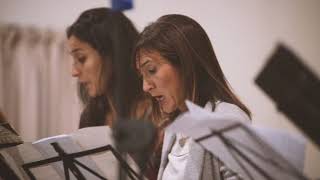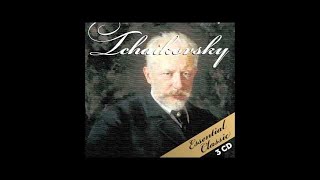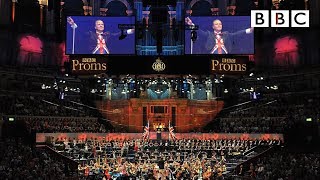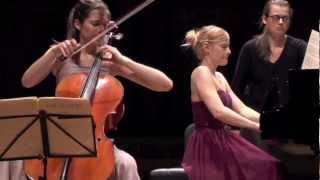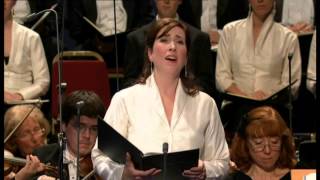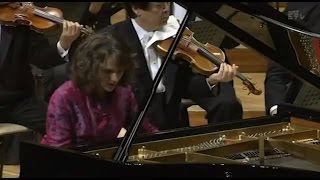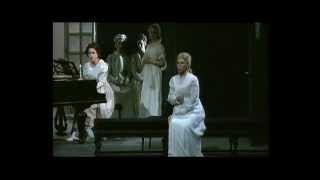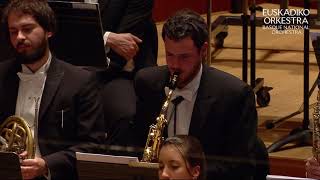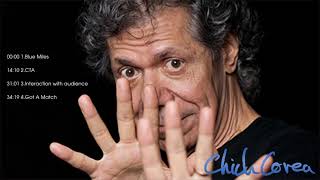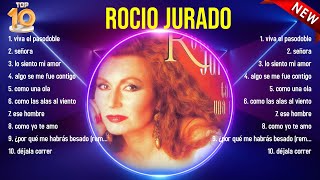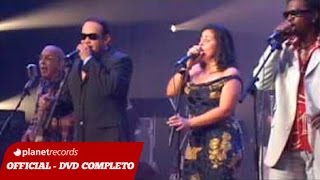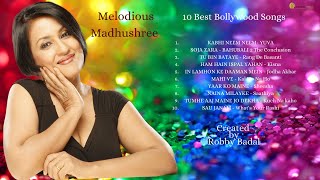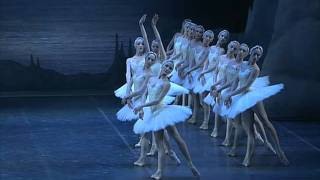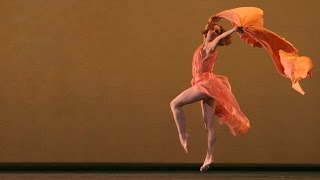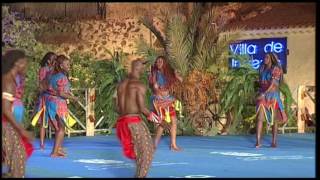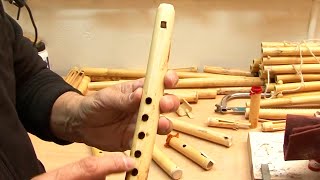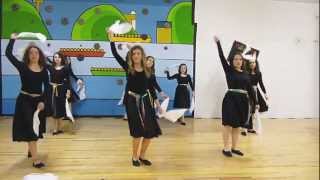May 9, 2024 Ascension Day
May 7: Brahms and Tchaikovsky are born
Recommended music videos for initiation to classical music
Bianca Maria Meda (1665-1700) was a Benedictine nun and composer of Italian music. No mention of his life has yet been found; only his name, which appears for the first time in 1677, in the documents of the Benedictine convent of San Martino del Leano in Pavia . She would have been 16 years old, the age at which, according to the custom of the time, young women entered convents. When he was about thirty years old, according to the above assumptions (1691), he published his only known compositions: " Mottetti a 1, 2, 3, e 4 voci ". With this collection, Meda became one of the few nun-composers in Italy , to see her work printed in the 17th century ; Only Isabella Leonarda , an Ursuline nun from Novara , followed her.
Today we present the Lacrime Amare motet in interpretation of the Cappella Artemisia .
Piotr Tchaikovsky (1840-1893) Russian composer who graduated from the Saint Petersburg Conservatory and wrote works of different and varied musical genres, although his greatest success was with his ballets. Unfortunately, his personal life was plagued by continuous personal crises starting at the age of 14, when his mother died, and also as a result of repressed homosexuality, which forced him to enter into a marriage that only lasted a few months. Despite the clear manifestations of his facility for music, his education was aimed at obtaining an official position in the Ministry of Justice , which he achieved in 1859. Without leaving his job, he enrolled in composition; At three years old, however, he abandoned his job to dedicate himself exclusively to musical study. He wrote more than 150 compositions, including works for piano, quartets, suites, symphonies, concertos, choirs, cantatas, operas and ballets. He died at the age of 53 and is currently considered one of the greatest composers in history.
The Best Works of Tchaikovsky I (0:00) Piano Concerto No. 1 Op. 23 - Allegro non troppo .-. II (8:56) Eugene Onegin Act III – Polonaise .-. III (14:00) Symphony No. 6 in B minor "Patética" - 1st mov. .-. IV (33:15) Violin Concerto in D major Op. 35 - Andante .-. V (40:06) Slavic March in B flat minor Op. 31 .-. VI (50:50) Ouverture 1812 .-. VII (1:06´:46´´) The Nutcracker Op. 71 - Ouverture .-. VIII (1:10:13) The Nutcracker Op. 71 - Dance of the Sugar Plum Fairy .-. IX (1:12:04) The Nutcracker Op. 71 - Waltz of the Flowers .-. X (1:18:43) Sleeping Beauty Op. 66 - Ouverture .-. XI (1:21:31) Swan Lake - Dance of the swans.-. XII (1:30:17) Swan Lake - Waltz in A major .-. XIII (1:37:51) Swan Lake - Scene from Act 2.
Edward Elgar (1857-1934) English composer born near Worcester . At the age of eight, he began his violin and piano studies. At age 22 he was appointed band director of the Powick Psychiatric Asylum ; He was part of the orchestra of the Worcester and Birmingham Festivals , performing Symphony No. 6 and Dvorak 's Stabat Mater conducted by the same composer. Faced with the difficulty of making himself known in London , he returned to Worcester to direct local bands and teach music classes. At the age of 42 he wrote the Enigma Variations that catapulted him as the most important British composer of his time. In 1904 he was knighted at Buckingham Palace ; From then on he received important recognitions and awards.
Pomp and Circumstance No. 1 is the first and best known of a series of five marches composed by Elgar ; It consists of two differentiated parts (fast-slow) exposed in repetitive mode (ABAB); In the present case, the slow part was used to embed a patriotic lyric “Land of Hope and Glory” that was sung for the first time at the coronation of Edward VII and that is currently usually performed at the BBC Proms as in the video that we suggest today directed by one of the most eminent Czech directors such as Jiří Bělohlávek (1946-2017) and which as an encore once again offers the final part of the work
Johannes Brahms (1833-1897), born in Vienna , where he spent most of his life, was the composer of the most conservative romanticism compared to the progressive current led by Liszt and Wagner . His music is firmly rooted in the compositional structures and techniques of the classical masters and his formal structures faithfully follow the patterns of classicism , although he uses some of the color of romanticism and popular music. Eminently perfectionist in nature, he wrote for piano, chamber ensembles, symphony orchestra, for solo voices and for choir. It was Hans von Bulow who proposed the “three Bs” referring to Bach , Beethoven and Brahms as the three main pillars of the History of music.
Catalog of Brahms' works . His works are classified by their Opus number ( from the Latin opus 'work'; op. abbreviation) which is a term used in music to catalog the works of most composers since the 17th century .
Cello Sonata No. 1 in E minor, Op. 38, was composed by Johannes Brahms between 1862 and 1865. The work is a tribute to JS Bach and the influence of what he considered his admired teacher can be seen. The piece is divided into three movements, of which today we offer the second, Allegretto Quasi Menuetto , in A minor.
Recommended classical music videos
Johann Sebastian Bach (1685-1750) was a German violinist, organist, conductor and composer, born in Eisenach into the most prominent musical family in history. In 1703 he obtained his first job in Arndstat and in 1707 he moved to Mülhausen as an organist, where he married his cousin Maria Barbara with whom he had seven children. After the death of his wife in 1720, he remarried Mary Magdalene with whom he would have another thirteen children. In 1723 he moved to Leipzig where he would live until his death at the age of 65. Considered one of the three main geniuses in the History of Music along with Mozart and Beethoven, his influence has been notable on Haydn , Mozart , Beethoven , Mendelssohn , Schumann , Chopin ... and many other renowned composers.
The catalog of Bach's works or Bach-Werke-Verzeichnis , better known by its acronym BWV , consists of a numbered index of all the composer's works arranged thematically by type of work, genres and according to their vocal or instrumental nature and used by academics and musicians from around the world. This catalog was created in 1950 by the German musicologist Wolfgang Schmieder .
Oratorio is a dramatic musical genre without staging, costumes, or sets and performed in the form of a concert. Generally composed for solo voices, choir and symphony orchestra, sometimes with a narrator, its theme is frequently religious (stories from the Bible or the Gospel , from the life of Jesus or the lives of saints, etc.), but can also be be profane (mythological heroes, historical themes, hymn to nature, etc.). Formally quite close to the cantata and the opera , the oratorio generally comprises an overture, recitatives, arias and choruses.
Ascension Oratorio, BWV 11 (Lobet Gott in seinen Reichen: Praise God in his kingdom) , is an oratorio written by Johann Sebastian Bach , for the Feast of the Ascension . The work was probably premiered on 19 May 1735. The additional text to the biblical and choral sources is believed to have been written by Picander with whom he had previously collaborated on the Christmas Oratorio . It is organized in two parts (2nd PART: 16'20'') to be interpreted before and after the sermon; version today conducted by John Eliot Gardiner (1943) , a prominent British conductor known, above all, for his historicist performances of Baroque and Classical music with period instruments.
The piano concerto No. 2 in B flat major, Op. 83, by Johannes Brahms is separated by about twenty years from his first piano concerto. It is considered by many pianists to be one of the most technically difficult pieces in piano literature. Unlike the first piano concerto, this one has four movements: I (0´32´´) ALLEGRO NON TROPPO .-. II (19´15´´) ALLEGRO APPASSIONATO .-. III (28´30´´) ANDANTE .- . IV (40´10´´) ALLEGRETTO GRAZIOSO. In this work, Brahms , following Liszt's example, alters the traditional scheme of the classical concerto, introducing, after the first movement, a fast second movement. The piece was premiered in Budapest on November 9, 1881 with the composer at the piano.
The French pianist Hélène Grimaud (1969) is one of the most outstanding performers of her generation. He descends from a family with different cultural heritage: on his father's side he has the Sephardic branch from North Africa , and on his mother's side he has Jews from Corsica . His family changed their surname (from Grimaldi to Grimaud) before he was born. At the age of seven he discovered the piano and began his training with Jacques Rouvier . He studied at the Marseille Conservatory and the Paris Conservatory. In 1987 he began his career as a soloist, in a recital with the Paris Orchestra conducted by Daniel Barenboim ; From this moment on he participates in numerous festivals and concerts around the world playing with the best conductors and orchestras.
Opera (from the Latin opera, plural of opus, "works") is a musical genre that combines symphonic music, generally performed by an orchestra, and a dramatic written text - expressed in the form of a libretto - performed vocally by singers of diverse backgrounds. tessitura: mainly, soprano, mezzo-soprano and contralto for the female register and tenor, baritone and bass for the male, in addition to the so-called white voices (those of children) or falsetto (castrato, countertenor). Typically, the instrumental part contains overtures, interludes, and musical accompaniments; while the sung part can be a chorus, a solo, duet, trio or various combinations and with various structures such as recitative or aria.
Pikovaya Dama (The Lady of Spades) is an opera in three acts with music by Pyotr Ilyich Tchaikovsky and a libretto in Russian by Modest Tchaikovsky (brother of the composer) based on the story of the same name by Alexander Pushkin . Tchaikovsky sketched the opera between January and March in Florence , in just 44 days; While composing the music, he frequently edited the libretto, changing some of the text and adding his own lyrics to two arias. The Queen of Spades was premiered on December 19, 1890 at the Mariinsky Theater in Saint Petersburg and, as the composer expected, it was a tremendous success. It had the same success twelve days later, when it was premiered in Kiev . On November 4, 1891, he performed at the Bolshoi Theater in Moscow . Tchaikovsky was tremendously satisfied with his work.
Maurice Ravel (1875-1937), born in Ziburu/Ciboure (Basque Country in France), inherited his meticulous work from his father, an engineer of Swiss origin, and his passion for music from his mother, born in Mendata (Bizkaia). with the folk songs with which he adorned his childhood. A few months after he was born, the family moved to Paris , where at the age of six he began his piano studies. At the age of 14 he entered the Paris Conservatory where he had the opportunity to study with Gabriel Fauré . In 1901 he premiered his Jeux d'eau , a piano work with which he began to make his way in the musical circles of Paris where the influence of Ravel on Debussy and vice versa was discussed. In 1921 he lived until his death in a mansion near Paris , where eminent musicians and intellectuals met.
The Bolero (Le Boléro) was created in 1928 and premiered at the Opéra Garnier in Paris on November 22 of that same year. The immediate success and rapid universal diffusion of Le Boléro made it not only one of the composer's most famous works, but also one of the exponents of 20th century music. It consists of a single movement inspired by a Spanish dance and is characterized by an invariable rhythm and tempo, with an obsessive melody - an ostinato - repeated over and over again without any modification except the orchestral effects, in a crescendo that, in extremis, ends with a modulation to E major and a thunderous coda.
Today it is offered to us by the French National Orchestra conducted by the Finnish maestro Dalia Stasevska (1984).
Recommended music videos for all tastes
Chick Corea (1941-2021) was a prestigious American jazz pianist, keyboardist and composer, winner of twenty Grammy Awards . In the 1960s, he participated in the birth of jazz fusion as a member of Miles Davis ' band, and became known for his work in that genre during the 1970s. He created the group Return to Forever with other virtuosos towards the end of 1971. Throughout the 1980s and 1990s he continued his collaborations with musicians such as Gary Burton and Paco de Lucia . Along with Herbie Hancock and Keith Jarrett , Corea is considered one of the most influential pianists after Bill Evans and McCoy Tyner . He composed several jazz standards: Spain, 500 miles high, Armando's rhumba, La Fiesta and Windows . He died at the age of seventy-nine.
Rocío Jurado (1943 - 2006) was an internationally famous Spanish singer and actress, who specialized in musical genres such as Andalusian copla and flamenco , as well as romantic ballads and melodic songs , a facet with which she achieved relevance in Spain. and in America . He was born into a middle class family, in Chipiona (Cádiz) and his first public performance was at the age of eight at his La Divina Pastora School . They called Rocío The Girl of the Awards , since she won all the awards from the radio stations in which she participated. Rocío was the first to replace the typical ruffled and polka-dot dress of the tonadilleras with elegant evening dresses and an international appearance. There were countless awards obtained both in Spain and in America .
Los Van Van is a Cuban orchestra, founded in 1969 by its director, bassist Juan Formell . From the moment of its founding, the orchestra added elements taken from jazz and rock to the sound , forming a rhythmic design in the percussion and a figurative piano with the bass, creating new harmonic and melodic timbres. In the first ten years they recorded their first five albums and debuted on several international stages. Later they incorporated trombones and introduced synthesizers and keyboards with multiple sound possibilities. The use of synthesized saxophone and electric violins attracted a lot of attention at that time. His texts offer themes that recreate the social circumstance and Cuban daily life with characteristic picaresque, irony and customs.
Madhushree (1969) is an Indian singer, performer of musical songs sung in Tamil, Hindi, Telugu and Kannada . She was born under her real name of Sujata Bhattacharya , into a Bengali Brahmin family of musicians in Bangalore , daughter of Amarendranath and Parbati Bhattacharya , who were her main teachers. As a classical music singer, Madhushree joined Rabindra Bharati University where she completed her academic training. She later began working for the Indian Council for Cultural Relations , through which she was appointed to teach classical music in Suriname (South America). Upon his return to India , he began to perform musical themes in different films that have enjoyed great popularity.
Recommended peculiar videos
Swan Lake , Tchaikovsky 's first ballet, is a fairy tale-ballet structured in four acts; It was commissioned by the Bolshoi Theater and premiered in 1877. The work, originally choreographed by Julius Reisinger , was not well accepted by the public or critics; which forced Tchaikovsky to a new approach and a new choreography, this time by Marius Petipa and Lev Ivanov ; Its revival at the Mariinsky Theater in Saint Petersburg achieved its first great success, which has continued to the present moment in which it has become one of the most renowned titles in world ballet.
The story tells of an impossible love between Prince Siegfried and Odette , a young queen turned into a swan along with her entire court by the spell of the evil sorcerer Rothbar . The young woman can only recover her human form at night and will only be freed from the curse by the one who promises her eternal love. Today we can see it in a version by Svetlana Zhakarova, Roberto Bolle and the La Scala Theater Dance Corps .
Tamara Rojo dances the first two waltzes from Frederick Ashton 's one-act ballet Five Brahms Waltzes in the Manner of Isadora Duncan , 2004.
Frederick Ashton saw Isadora Duncan dance in London in 1921. It would be one of the most lasting influences on his life. Duncan 's freedom of movement, the intense intensity of his dancing, and the way he seemed to fuse music and dance were profound influences on Ashton 's own choreographic style. Nearly fifty years after seeing her perform, Ashton recalled: “She had the most extraordinary quality of repose. “She would stand for what seemed like a long time doing nothing, and then she would make a very small gesture that seemed full of meaning.” (Extracted from the bottom of the video)
The artists of the Jammu Folkloric Ballet take us to the heart of Africa , to its sounds, rhythms and colors. This Folkloric Ballet was born in Dakar in 2008, directed by As Ndiaye , in which two ideas merge: that of creating a stable folklore group and at the same time a music and dance school. Its headquarters are in the Yoff Cultural Center , a seaside neighborhood of Dakar , where young musicians and dancers from all ethnicities of Senegal participate and in their shows we will discover traditional Senegalese dances but also choreographies with elements of contemporary dance. Their impressive dances combine energetic movements with spectacular acrobatics, based on the Mbalax rhythm. This rhythm is obtained with the Sabar drums , used for centuries by the Wolof ethnic group of Senegal .
Reeds or reeds are an essential accessory for instruments such as the oboe, bassoon, English horn, clarinets and saxophones ; They are part of the Woodwind family, because those reeds are responsible for producing the sound by vibrating with the wind that is produced when blowing.
Recommended music videos for children
Various Wikipedia articles have been used to write these texts.
The texts of Videomusicalis are written in Basque, Spanish and English.





